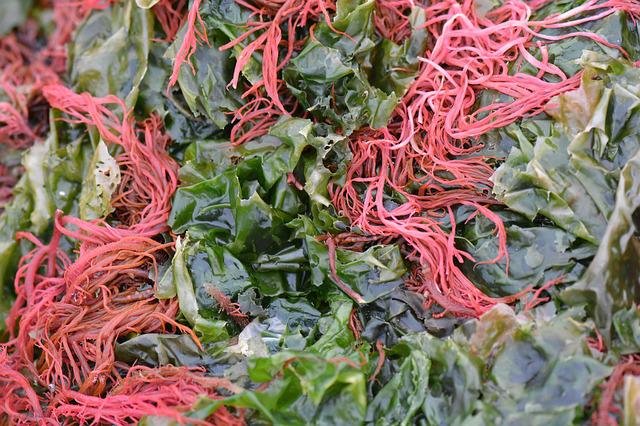
Algae provide the body with numerous substances that are important for its proper functioning: let’s find out why we should introduce algae into our diet and when to use them as supplements to keep our body healthy.
Algae are organisms of great interest from a nutritional and health point of view because they are rich in proteins and essential amino acids, which make them an excellent food to supplement the protein intake in vegetarian or vegan diets, they are an excellent source of vitamins (especially of group B), minerals, polyunsaturated fatty acids and pigments with antioxidant action.
A high molecular weight polysaccharide with immunostimulating action has also been isolated in many species of algae, and several algae also have antiviral and anti-inflammatory properties.
Compounds that are used in the food, cosmetic and pharmaceutical industries are extracted from the wall of various algae: these are ficocolloids, alginates, fucans. These substances are used as food additives and in natural products for the well-being of the gastro intestinal tract.
According to studies, some algae are able to chelate heavy metals, protect against tumors, have anti-inflammatory and antiviral action and help lower the level of cholesterol in the blood.
So let’s see in more detail the characteristics, properties, benefits and use of the different algae (red, brown, green and blue), both in the kitchen and in the form of food supplements.
Algae: characteristics and classification
Algae are eukaryotic and autotrophic organisms linked to the aquatic environment. They can live in salty, brackish or fresh waters but also in very humid soils or on tree trunks.
Algae can be unicellular, colonial or multicellular and, in the latter case, they are defined as tallophytes because they are characterized by a thallus: unlike higher plants, which are equipped with different structures for different functions, algae have little or no cells differentiated, able to perform the same functions.
The rhodophytes, the phaeophytes and the chlorophytes are part of the algae; cyanobacteria (or blue algae) are also included in the algae, since although they are prokaryotes, ie cells without a nucleus, they are endowed with chlorophyll.
Blue algae: health supplements
Blue algae, or cyanophytes, are organisms that colonize hostile environments, such as very hot thermal waters. They are similar to bacteria but differ from them by the presence of chlorophyll.
In addition to chlorophyll, blue algae contain carotenoids, xanthophylls and phycobilins; the latter are water-soluble pigments that include phycocyanin, responsible for the blue color. In addition to the antioxidant action carried out by the pigments, the blue algae provide vitamins, minerals and essential fatty acids. Furthermore, a polysaccharide with immunostimulating activity has been isolated in blue algae and appears to lower cholesterol levels.
Two blue algae that we can find on the market in the form of supplements are the Spirulina algae and the Klamath algae: the Spirulina algae is very well known because it contains vitamin B12 but it should be noted that it is not a source for vegetarians and vegans since the cobalamin in this alga is present in a form that cannot be used by our body.
Red algae: for weight loss and more
Red algae, or rhodophytes, live in warm seas and thanks to their chromatic adaptation they can remain on the surface or colonize the waters even at very high depths. Red algae are equipped with chlorophyll, phycocyanins, xanthophylls and carotenoids and are rich in proteins, vitamins, minerals and essential fatty acids.
Red algae are particularly interesting for the food and cosmetics industry as they contain substances called ficocolloids in their walls, including agar and carrageenan.
Agar is mainly extracted from the gelidium genus and is a natural substance that gives a colloidal solution when dissolved in hot water. It is used in pharmacies and herbal medicine in the treatment of constipation as a mechanical laxative since it is not assimilable and fermentable by intestinal bacteria, it increases the mass of feces. Agar also has an emollient action on the intestinal mucosa and is beneficial in case of chronic constipation and inflammation of the gastrointestinal mucosa.
Agar is also used in the kitchen as a gelling agent to replace isinglass, which is instead of animal origin: it is purchased in natural and organic products stores and is used to prepare puddings, caramel creams, vegetable cheeses and jellies in vegetarian diets and vegan.
Carrageenan is obtained mainly from Irish Moss and has an emulsifying, gelling and thickening action. It is used in ice cream to avoid the formation of crystals and in dairy products to reinforce the cohesion of milk proteins. Like agar, carrageenan is also used as a mechanical laxative and as a protective mucus.
Both agar and carrageenan have protective mucus action and are used in slimming diets as they increase the sense of satiety.
Among the red algae used in nutrition we also remember the Nori seaweed, used to prepare sushi, and the Dulse seaweed, which is mainly eaten raw as a salad, even if not very digestible.
Brown algae: flavor and health in the kitchen
Brown algae, or phaeophytes, include about 1500 species, are mainly multicellular and prefer cold seas. Some live on the surface of the waters, as in the case of the Sargassum that we find in the Sargasso Sea, where it forms real floating masses; others colonize seas up to 90 meters deep; some brown algae can reach considerable dimensions as in the case of the sea giants, the Macrocistis, which measure up to 80 meters in length. In some species the thallus may be covered with calcium carbonate.
Brown algae, like the others already seen, contain chlorophyll, beta carotene, minerals (in particular iodine and potassium), B vitamins and polyunsaturated fatty acids; they are also rich in fucoxanthin.
Thanks to the substances contained in them, according to some studies, brown algae have an antioxidant action, are able to protect against the onset of tumors and have anti-inflammatory and antiviral properties.
Brown algae are also interesting for the content of polysaccharides, substances capable of retaining water and absorbing heavy metals: alginates and fucans.
Alginates are composed of d-mannuronic acid and l-glucuronic acid and are exploited for their ability to form colloidal solutions in an acidic environment: they are used together with sodium bicabonate and aluminum hydroxide in products used to counteract gastric reflux.
In fact, alginates, in contact with the acid content of the stomach, form a gelatinous solution which on the one hand physically prevents the gastric contents from rising towards the esophagus, and on the other protects the esophageal mucosa from acidity.
There are several brown algae that are used in the kitchen, as they give a strong flavor to the recipes: among these we remember the Kombu seaweed, used to prepare broths, the Wakame consumed as a side dish, in salads and in miso soups and the Hijiki seaweed and Arame, used to flavor sauces and vegetables.
Finally, how can we forget the Fucus seaweed, a brown seaweed that is not used for food but is widely used to promote weight loss and to bring iodine to the body.
Green algae: an aid to the immune system
Green algae, or chlorophytes, can be unicellular, united in colonies or multicellular and are widespread in fresh and salt waters, brackish waters, soils and humid environments. Among the pigments of green algae chlorophyll prevails but they also contain carotene and xanthophylls.
Green algae are particularly rich in proteins, so much so that the use of these organisms to make protein flours for undernourished populations has been studied for some time.
Among the green algae we mention Chlorella, a unicellular algae interesting for its protein content (up to 50% of its dry weight) and for its richness in essential amino acids. Chlorella is used as a food supplement because, in addition to its high protein content, it is rich in provitamin A, vitamin C and a high molecular weight polysaccharide with an immunostimulating action.






